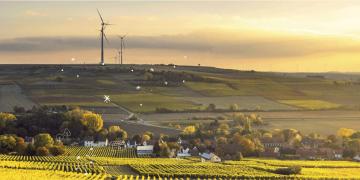Mirovα, Creating Sustainable Value - Private markets - 2024
2023 Review and 2024 Outlook
Review and outlook at a glance

Energy transition infrastructure :
• An environment of easing interest rates, conducive to investments in green infrastructure in 2024.
• Many opportunities both in traditional energy production capacities (wind, solar, hydro) and in fast-evolving technologies (energy storage, energy efficiency, hydrogen or electric mobility).
• Joint investment needs in OCDE1 countries and emerging economies.

Private Equity2
• A slowdown in fundraising over 2023 and 2024, but segments unevenly affected: buy-out/capital transmission and venture capital/risk capital are suffering, while impact and ESG funds are attracting investors. Growth/acceleration capital remains insufficiently covered by investors.
• In 2024, extension of our strategy in the early growth environment, and launch of a societal strategy at the same investment stage.
• Acceleration of private equity development among private investors.

Natural Capital
Sustainable land use :
• Increased regulatory pressure in 2024 to transform value chains, particularly in the agri-food sector (e.g. the fight against imported deforestation in Europe).
• Major investment opportunities driven by investor interest and an accelerating pace of business transformation.
Sustainable ocean management :
• Chronic underinvestment in ocean protection.
• An array of international initiatives to attract financing and conserve marine resources.
• Investment opportunities in the protection of oceans and marine species and in sustainable economic activities.
Environmental assets :
• Reinforcement of the voluntary carbon credit2 market in 2023, based on clarified and more restrictive frameworks and methodologies.
• Positive prospects for 2024 and 2025 for the market in nature-based solutions for decarbonisation and the emergence of biodiversity certificates.
Energy transition infrastructure: time to accelerate
2023-2024: from decline to recovery
In 2023, the infrastructure market suffered the consequences of rising interest rates. This affected the capacities of many institutional investors, particularly insurers, to invest in non-listed assets. Not all segments were affected to the same degree, with real estate and buyouts among the worst, while energy transition infrastructure was largely spared. At Mirova, we are continuing to raise funds in energy transition infrastructures with a 4th strategy dedicated to emerging countries (since the end of 2022) and a 6th strategy dedicated to OECD markets (since the end of 2023). 2023 demonstrated the financial strength of non-listed infrastructure, particularly compared with listed securities. The latter, such as turbine manufacturers and developers, sometimes took a hit to their profitability due to inflation and saw their valuations fall. Non-listed companies, despite some financing difficulties, benefited from windfall effects, thanks in large part to the excess profits generated by energy prices.
The easing of interest rates at the end of 2023 marks a clear shift in favour of investment in non-listed securities, and more particularly in green infrastructure. Institutional investors are showing a willingness to increase their investments again after the pause of 2023, and are keen to focus their investments on projects covered by Article 93, which is the very basis of our positions. We are therefore optimistic for this year. If the reduction in investment volumes were to continue, it would mainly penalise new entrants rather than players who already have a network and solid partnerships, such as Mirova.
Added to this is the weight of regulation which, by marking out a path towards a low-carbon economy, is forcing Europe to build and buy infrastructure. Another important factor is the war in Ukraine, which has underlined the need for energy sovereignty and encouraged the formulation of national plans to produce green energy. There will therefore be many investment opportunities over the coming years, especially as the transition infrastructure sector is still suffering from under-investment in relation to needs.
Private Equity: why we are confident
An overall slowdown in fundraising, but impact and growth capital are holding up
The year was marked by an overall slowdown in private equity fundraising. Given the unlikelihood of a strong acceleration in macroeconomic activity, a sharp upturn in fundraising is not to be expected in 2024. Furthermore, investors appear not to have the intention of significantly changing their allocations between listed assets and private equity. However, the fall in fundraising has varied depending on the market segment, with the most affected being buyouts, which are exposed to debt and penalised by the inflationary environment and rising interest rates.
Conversely, the impact segment and ESG funds have been protected because they remain themes that attract investors and lead toresponses to the crisis. As a result, flows here have declined less substantially,and 2024 looks set to be a robust year. At Mirova, we successfully raised our first environmental impact private equity vintage.It should also be noted that not all countries were affected to the same extent by the slowdown in fundraising.

Natural capital: the impact path
Sustainable land use
Accelerating the transformation of supply chains
Multinationals are becoming increa- singly aware of the importance of changing their sourcing practices in order to preserve and secure the quality of their raw materials - and therefore of the soil - and their finished products over the long term. The issue of the resilience of supply chains - particularly agri-food supply chains - is becoming key, at a time when agricultural yields are dropping due to intensive farming practices that have damaged soil quality, but also as a result of climate change involving periodic droughts, storms, etc.
Regulatory pressure is also fuelling this trend. For example, the European regulation on defores- tation-free supply chains prohibits the marketing or export from the European market of products that have contributed to deforestation or forest degradation after 31 December 2020 - the products concerned being coffee, cocoa, rubber, palm oil, soya, cattle and timber, as well as derived products such as leather, charcoal and printed paper. Companies are now liable to financial penalties if they fail to comply with these regulations. In addition, the Nature Restoration law sets the objective of restoring at least 20% of the EU's land and sea areas by 20304 and all the ecosystems that need it by 2050. Finally, the entry into force of the CSRD5 and the SFDR6, with their increased transparency and reporting requirements, coupled with the growing focus on carbon footprints and zero carbon trajectories, will further increase the pressure on companies, especially as these new reporting frameworks encourage investors to be more vigilant. With this in mind, companies are adopting more ambitious zero carbon trajectories, reducing their carbon footprint in particular through regenerative farming practices that use less energy-intensive chemical inputs.
The combination of these factors is leading to a profound transformation of supply chains in the agri-food sector and beyond, for example in cosmetics and fashion. This is a buoyant investment theme, which can be likened, in asset class terms, to agroecological infrastructure.
It results in investing the capital needed to transform agricultural production methods and, as the regulatory and financial framework becomes more structured, it means that producers and companies in the supply chains will be able to reap the rewards and increase market share.
Sustainable ocean management
From awareness to financing
The oceans play an essential role in maintaining the Earth's major balances, in particular climate regulation, the preservation of biodiversity, food security and the livelihoods of a large number of human beings. Yet the issue of protecting the oceans is less mature than that of protecting land, and suffers from chronic under-investment. As proof of this, the United Nations’ Sustainable Development Goal number7, dedicated to life below water, is the one that receives the least investment8. Nonetheless, as awareness grows and regulations evolve, ocean protection is becoming more structured and now requires investment to support promising projects with a strong environmental and social impact. Several international movements confirm this trend. The Biodiversity COP 1515, held in Montreal in 2022, has helped to translate the need to protect the oceans into clear objectives, including the protection of 30% of marine ecosystems9. In 2025, the United Nations Ocean Conference will be held in Nice and will also help to put the health of the oceans at the heart of international concerns. Consequently, this issue will continue to rise on the political and economic agendas, and resonate with the general public.
Environmental assets
These investment strategies enable institutional and corporate investors to contribute to the global objectives of protecting nature ('Nature Positive') and achieving carbon neutrality ('Net Zero').
A carbon credit market gaining structure
Several levers will need to be pulled to meet the carbon targets set internationally for 2030 and then 2050. By 2030, nature-based solutions should account for 30% of this target, thanks to avoided emissions (60%), but also via natural carbon sequestration (40%)10. Voluntary nature-based carbon credits represent a complementary solution to corporate decarbonisation strategies (via an "Avoid, Reduce, Offset" approach), but have suffered from a lack of reliable reference frameworks, methodologies and traceability on the ground.
2023 saw a fresh start for this market, thanks to a series of structuring initiatives aimed at standardising the quality of voluntary carbon credits (the IC-VCM11 initiative defined a reference framework for the integrity of voluntary carbon credits, the "Core Carbon Principles") as well as the quality of their buyers, and in particular the robustness of their low carbon trajectory and their declaration (the VCMI12 initiative). These two initiatives, together with SBTI13, GHG Protocol14 and CDP (Carbon Disclosure Project), announced their collaboration at COP28 to ensure that their initiatives are aligned, thereby helping to strengthen the standards and robustness of voluntary carbon markets throughout the chain. At the same time, carbon certification players (and Verra15 in particular) significantly strengthened several of their methodologies.
This new-found clarity on the framework and methodologies provides the necessary reassurance for investors wishing to invest in the carbon credit market. This increased confidence, combined with the very significant increase in decarbonisation commitments made by companies, was reflected in a significant rise in the number of companies buying carbon credits in 2023 (more than 1,000 new buyers out of a total of 4,500 by the end of 2023 according to Allied Offsets)16.
Conclusion
Non-listed assets constitute a multi-dimensional asset class, which has been affected to different extents by the rise in interest rates in 2023. The economic climate has been one of the causes of a reduction in financing for certain private assets, but has also confirmed an acceleration in investment in favour of the green transition. While access to deals and projects has become more difficult for new market entrants, the context is, in contrast, conducive to opportunities for established players such as Mirova.
The solidity throughout 2023 of the projects and companies in which we had already invested together with our ability to raise funds and find quality deals confirm the full potential for return and diversification that we see in the non-listed segment. Additionally, the structuring of different markets around environmental, energy and societal transitions, the tightening of regulations and investor interest in sustainable operations are all acceleration factors which whose effects we will start to feel in 2024.
1. Organisation for Economic Cooperation and Development.
2. Carbon credits are certificates for the avoidance, reduction or removal of tons of CO2, or its equivalent of other greenhouse gases,
given to projects that can then sell them to players who want to help reduce greenhouse gas emissions.
3. The Sustainable Finance Disclosures Regulation (SFDR) aims to provide greater transparency in terms of environmental and social
responsibility within the financial markets, notably through the provision of sustainability information on financial products. Article 9
funds have a sustainable investment objective.
4.Source: Nature Restoration Act, European Parliament, 2023.
5. Applicable from 1 January 2024, the European Corporate Sustainability Reporting Directive (CSRD) sets new standards and obligations
for non-financial reporting. It applies to large companies and listed SMEs.
6. Sustainable Finance Disclosures Regulation (SFDR).
7. Source: OECD, 2022.
8. The COP, or Conference of the Parties, is the common name for the annual meeting of governments to set global climate targets.
9. Source: Kunming-Montréal Global Biodiversity Framework, Conference of the Parties 15 dedicated to biodiversity, 2022.
10. Source Corinne Le Quéré et al., Global Carbon Budget 2018, Earth Systems Science Data, 2018, Volume 10, Number 4, doi.org; IPCC; McKinsey Global Energy Perspective 2019: Reference Case; McKinsey 1.5°C scenario analysis.
11. Integrity Council for Voluntary Carbon Markets.
12. Voluntary Carbon Market Initiative.
13. Science Based Targets, also known as the SBT initiative or SBTi, encourages companies to set science-based greenhouse gas emission reduction targets.
14. An international protocol proposing a framework for measuring, accounting and managing greenhouse gas emissions from private
and public sector activities developed by the World Business Council for Sustainable Development (WBCSD).
15. Verra is a non-profit organization specializing in carbon certification.
16. Source: Allied Offsets, which provides carbon data based on 21 registries, including Verra VCS, Gold Standard, ACR and CAR.






